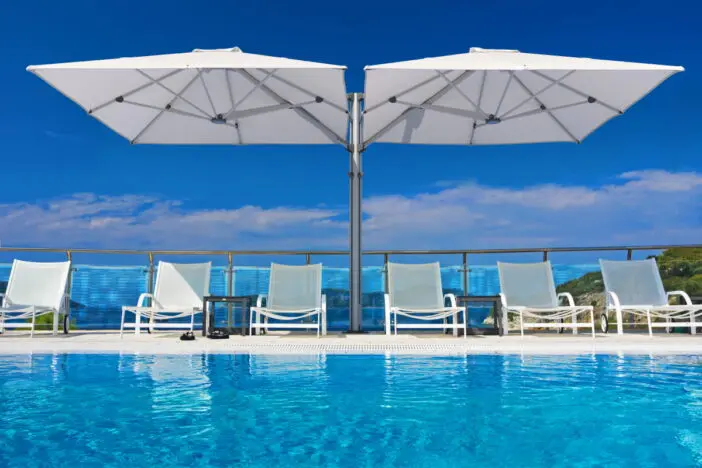
What is the best patio umbrella?
The answer is – that depends. There are many things to consider when buying a sun shade. Modern architectural design seamlessly transitions from indoor to outdoor spaces. Elaborate decks and lavish pool furniture allow you to enjoy nature, without sacrificing style or comfort. So, as spring and summer arrive, you’ll spend more time outside entertaining or lounging poolside. To keep you and your guests cool and protected from the hot sun, it’s important to have ample shade.
Patio umbrellas are great if you don’t want to invest in a pergola, cabana or other permanent shade structure. The global outdoor umbrella market has an estimated growth rate of 6.8 percent. It’s forecasted to reach $2.16 billion by 2030 per Persistence Market Research. However, choosing the right one can be challenging. There are many factors to evaluate based on your home, environment, budget and preferences. This guide will help you better understand the component parts of patio umbrellas, their design styles, materials and features. As a result, your buying decision will be easier and allow you to relax outside for years.
Selecting the right outdoor umbrella
You’re ready to invest in a high-quality shade but want to know which is right for your al fresco setting. There are many factors to consider. Some are subjective like how you’re going to use the umbrella and what style or color do you prefer. Others are objective such as the size and layout of your space and climate. The ease of assembly and installation are also important depending on your DIY capabilities. They all impact what kind of outdoor umbrella best suits your needs and wants.
Read through the sections of this buying guide below to get the insight you need.
Here’s what each section covers:
- Types, Sizes & Shapes – A look at market and cantilever umbrellas, and tips on figuring out what size and shape canopy is right
- Materials & Fabrics – An overview of different materials used for the frame, pole and canopy fabric and their durability
- Bases & Mounts – A thorough review of the various kinds of freestanding bases and fixed mounts for stabilizing your shade on different surfaces
- Features & Accessories – A rundown of options like multiple canopies, tilting and valances, as well as add-ons such as LED lights and Bluetooth speakers
- Use & Wind – A checklist of operational functions to open, close and use the shade with attention to the Beaufort wind force scale
- Maintenance & Cleaning – A list of generally recommended practices to ensure your umbrella continues to operate and look great for a long time
Patio Umbrella Buying Guide Sections
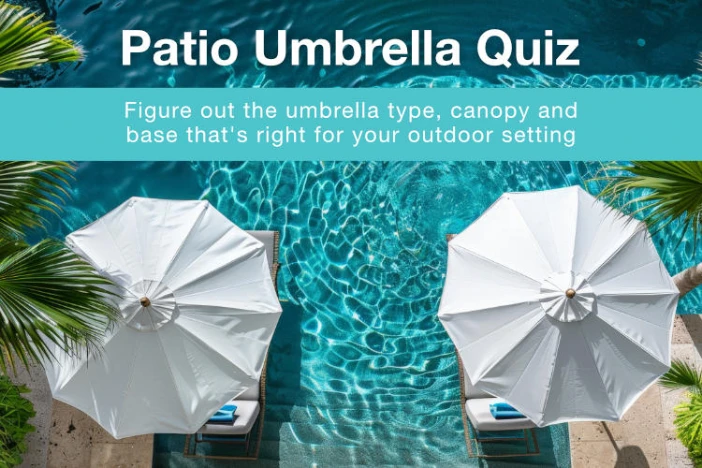
What are the parts of a patio umbrella?
Before diving in, it may be helpful to go over the various components that make up these sunshades. Knowing umbrella parts and terminology will make it easier to follow along. And, it’s a reminder that there are many individual pieces working together to ensure peak performance. Additionally, when researching and comparing different brands and models, it’s good to understand the various components, functions and options.
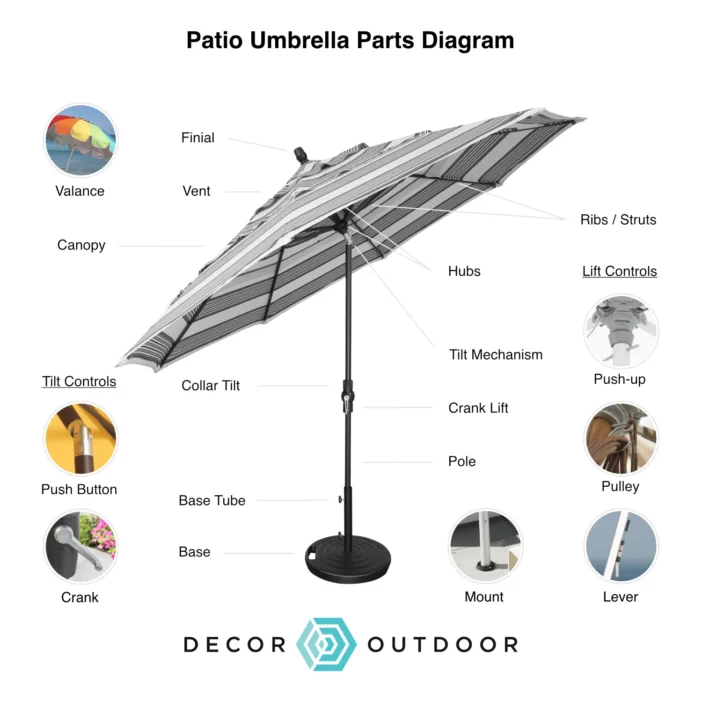
Pole
For traditional market umbrellas, a solid vertical rod or pole is the main support for the canopy. They’re available in several standard diameters, although thinner ones may come in two pieces for easier shipping and storage. There are also telescopic poles that enable you adjust the height of the canopy. Single pieces and thicker poles are more resilient to windy conditions.
Cantilever-style parasols have an offset design to support the canopy. They’re multi-jointed and often rotate 360 degrees, whereas center pole models have a more limited shade area. A side post umbrella design extends the canopy over a dining table. Conversely, a center pole model must pass through an umbrella hole to shade the same area.
Both umbrella designs are typically made of metal or wood. Powder-coated stainless steel or aluminum frames and poles are often used. The finish protects against corrosion and complements decor color palettes. Durable teak, bamboo and meranti are among the more popular hardwoods used for outdoor parasols.
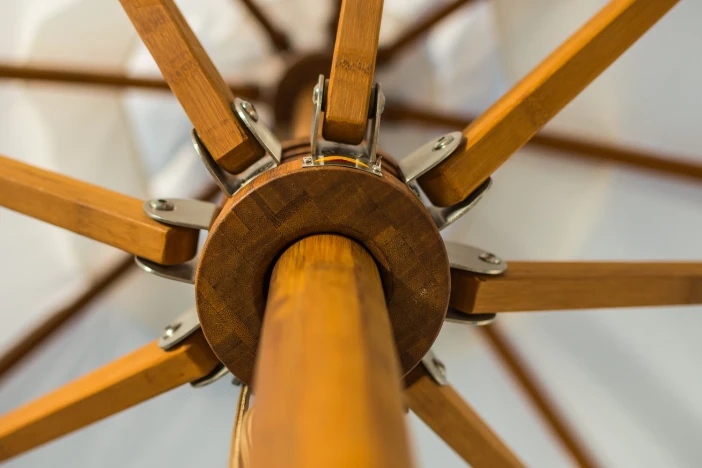
Ribs or Struts
The slender pieces that give canopies their shape and hold them in the open position are called ribs or struts. There are two types of ribs:
- Main Ribs (long ribs) – Attach to the top center of the frame and extend beneath the outer edge of the canopy
- Support Ribs (short ribs or struts) – Connect to the underside of the main ribs and control the opening and closing of the canopy
These pieces usually match the material of the frame or pole. Sometimes, however, canopies use fiberglass ribs. The flexible material provides ample support and bends in the wind. This provides a little extra durability in coastal or blustery settings.
Hubs
The ringed apparatus that works with the ribs is called a hub. There are two types of hubs:
- Top Hub – Located at the top of the pole, this hub holds the main ribs in place
- Runner Hub – Located further down the pole, this hub connects to the support ribs and glides up and down to open and close the umbrella canopy
These connection parts may be made of wood, metal or molded nylon.

Finial
A finial or ferrule sits atop a canopy. It’s both functional and decorative, as it anchors the canopy to the pole and provides a bit of aesthetic flair.
Canopy
The canopy is the fabric that blocks the sun. In addition to the overall shade body, there are often two additional parts to a canopy:
- Vents – Canopy layers allow air to pass easily through the fabric. This helps cool the air below, while enabling the umbrella to handle high winds more effectively
- Valances – Flaps of fabric that overhang the perimeter of the canopy. They can be seen on many beach or cafe-style shades (scalloped edge is a variation) and are chiefly decorative
Canopies are ultimately the most critical component of a patio umbrella in protecting against harmful UV rays. A fabric’s UPF (Ultraviolet Protection Factor) rating indicates how much radiation is blocked. Most high-quality shades are UPF 50+ and are made of solution-dyed acrylic, polyester or olefin.
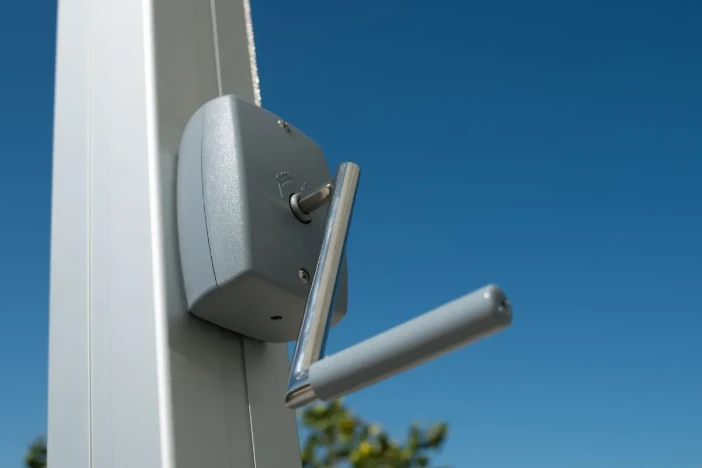
Lift Mechanism
Market and cantilever umbrellas are opened when the runner hub and support ribs are raised by the lift mechanism. There are multiple types to choose from:
- Push-Up – The lower runner hub is pushed upward manually. A locking system (often a post or pin and hole) secures the umbrella in its open position
- Crank – A rotating handle is turned clockwise to open the canopy and counterclockwise to lower it
- Pulley & Pin – A rope is pulled down to open the canopy. It’s secured in place by inserting a pin into a hole below the runner hub
- Lever & Latch – A lever is pulled down and latched into place to secure the canopy in its raised position
If you’re running your umbrella pole through a tall table, check the height of the lift mechanism. Make sure that it clears the tabletop so you can operate it properly.
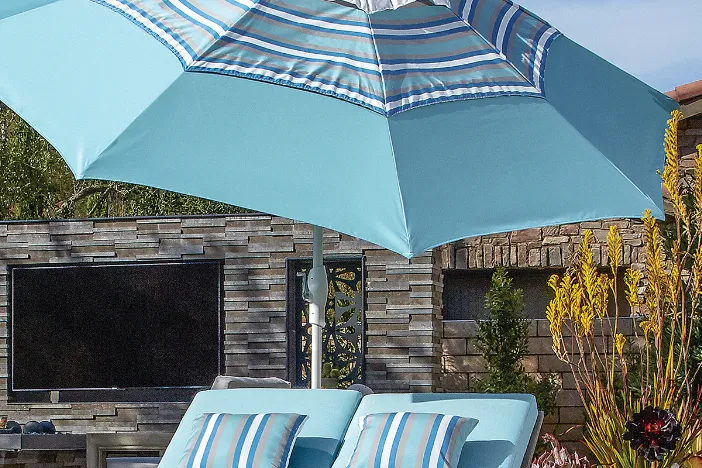
Tilt Mechanism
Some umbrellas allow you to tilt the canopy to direct the shade as the sun moves throughout the day. This can be beneficial in residential installations with close quarters. Unfortunately, tilting umbrellas are also more likely to break down since the pole is less stable. There are a few types to choose from:
- Push Button or Manual – A button is pushed to unlock the canopy. Then, it can then be manually tilted to a variety of angles (often preset)
- Automatic or Crank – Once the canopy is completely open, continued cranking will tilt to just short of 90 degrees
- Collar – A sheathed apparatus, located above the crank, is twisted until the desired tilt angle is reached
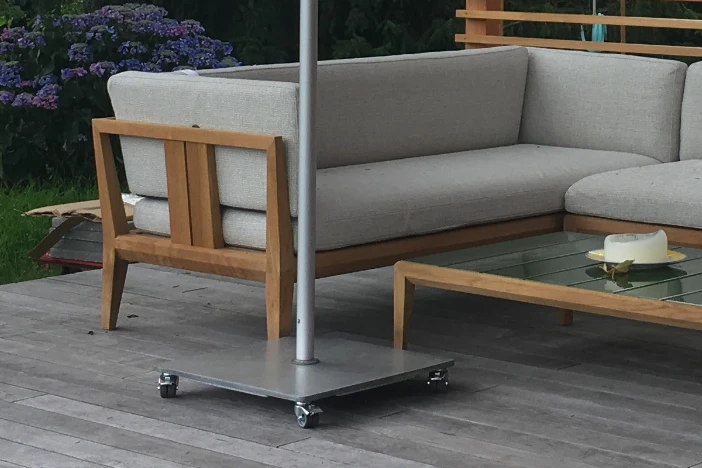
Base
Freestanding patio umbrellas are stabilized by a weighted base or stand. They keep them upright and prevent tipping over in windy conditions. Bases are made out of a variety of heavy materials. Solid bases are typically steel, iron, concrete or stone. Steel framed bases often hold concrete or metal pavers. They can be covered with an aluminum or plastic lid, or remained open altogether. Filled versions usually have plastic shells that contain sand or water.
Mount
Sun shades may also be secured by a permanent mount. There are different types of mounts based on the surface and whether you want to be able to easily remove your parsol. They’re typically made from stainless steel and may be designed for securing to an existing surface (e.g. cement patio or hardwood deck). Other mounts include an in-ground portion that’s stabilized by poured concrete. Once a mount is secured in place, an umbrella is bolted down to it.
Frequently Asked Questions – Patio Umbrellas
Do shade umbrellas block UV rays?
Outdoor umbrellas do block much of the harmful effects of direct ultraviolet rays. The large the umbrella, the greater the area of protection. However, the material and color of the canopy impact just how much. Here are some key factors:
- Weave – The tighter the fabric is woven together, the less UV radiation passes through
- Color – Dark colors of identical fabric types absorb ultraviolet rays more strongly than their lighter shades, which increases the sun protection
- Weight – A heavier version of the same fabric will be minimally more protective against UVR
- Stretch – The greater the stretch or tension put on a textile, the lower the UPF rating
- Water – Some fabrics, such as polyester and cotton, provide less protection against UVR when they have absorbed water
- Washing – Cotton-based fabrics tend to shrink after the first washing, thereby tightening the weave and reducing the transmitted ultraviolet radiation
- Additives – UVR stabilizers or additives can be used to improve the sun protection of a variety of textiles
Additionally, you need to be aware of indirect UV rays that are reflected off of water, glass and light-color walls.
Who makes the best pool umbrellas?
There are countless manufacturers of outdoor patio umbrellas. They offer a wide range of products that appeal to a variety of budgets. Many of these brands provide value for a low cost and are certainly good options in the short run. However, as a retailer of luxury outdoor furnishings, Decor Outdoor focuses on products that perform and look great over the long run. The following brands may be more expensive, but their premium umbrellas have cutting edge designs and are made from the finest materials, using state-of-the-art manufacturing techniques. These collections are also backed by industry-leading warranties and service agreements.
- Tuuci – Unique and innovative shade solutions with thoughtful, refined designs that enhance the natural ambiance of the outdoors for years.
- Jardinico – Flawless elegant patio umbrellas with slim profiles, taut shades and impeccable finishes to provide a finishing touch to classic outdoor settings.
- Shadowspec – Stunning luxury outdoor umbrellas with evolutionary designs, patented technology and marine-grade materials.
- Woodline – Sophisticated center pole and cantilevered umbrellas designed to the highest standards using anodized aluminum, marine-grade stainless steel and kiln-dried eucalyptus.
- Umbrosa – State-of-the-art, elegant and understated shade solutions inspired by nature and built to last.
- Shademaker – Architectural grade shades with contemporary, precision-engineered designs for high end residential and commercial outdoor applications.
- Bambrella – Eco-friendly bamboo umbrellas with sleek, modern designs that are extremely weather-resistant – even in the windiest conditions.
- FiberBuilt – Commercial-grade patio umbrellas with flexible fiberglass ribs that are resilient under strong winds and last 4-5 times longer than steel or wood.

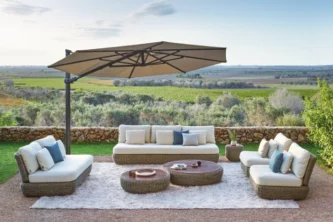
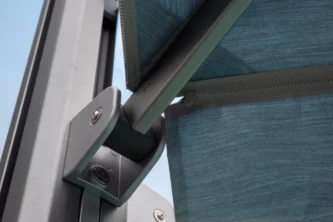
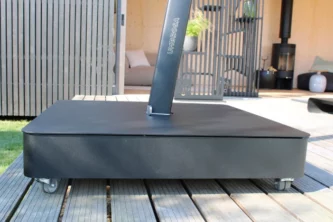
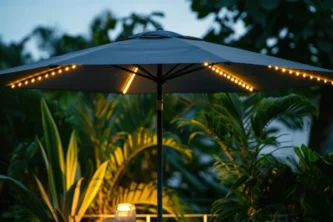
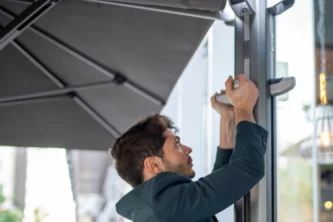
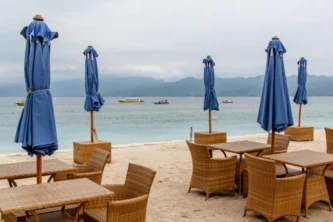




I built a tall table for use between a couple of tall Adirondack chairs. The top of the table is 39″ so the crank on an umbrella would need to be at 45 inches or so. Is that something that they make umbrellas for? How do I specify that?
Not all market umbrellas have a crank lift, so a manual push-up lift would not have that issue. There are also telescopic poles with some umbrellas that extend to put a crank above the tabletop. Be sure that the canopy can close as well.
Hello! I am planning a pool area with several lounge chairs in a row and flush ground inserts for umbrellas. I am planning to purchase 2 market umbrellas and four ground inserts so I can move the umbrellas around as needed. I was thinking I could put 2 at the “foot” end of the chairs and 2 at the “head” end of the chairs and place the ground inserts on the sunny side of the chairs. Or course I will make sure when open they are at least 9 feet apart so as not to touch. But wanted to ask if you have any other thoughts or suggestions about placement for such a situation as mine?!? Thank you in advance for your time and consideration.
Obviously, the number and spacing of the chairs along with the positioning relative to the sun matters. Were you thinking of rotating the chairs 180 degrees when the sun changes, so the umbrellas can always be placed behind the “head” and not obstructing the view as you face the “foot?”
Depending on the size of the canopy, you may be better off placing the ground mounts such that the umbrellas are between the chairs.
I’m looking for a replacement string for my 11 foot crank cantilever umbrella
Who is the manufacturer?
This is the best site I’ve found providing information on umbrellas. I feel like I’ve been to umbrella school. Thank you, you are a great resource.
I’m looking at two 9′ patio umbrellas. One has 6 ribs, one 8 ribs. Would this make a difference in sturdiness?
Thank you!
Melissa –
All other things being equal, more ribs would typically mean more support. However, the shape of the canopy can also dictate the number of ribs needed for adequate stability.
What is your recommendation for an in-pool “beach landing “ umbrella?
There’s a pre-made hole to insert umbrella pole.
You’ll need to look for a metal market umbrella that is marine-grade or at least has a protective powder coating.
Helpful article. What weight would you recommend for a 12 cantilever umbrella in a breezy environment?
Ideally, in windy conditions, you would use a permanent mount in concrete or your deck. You can probably go 10 pounds per canopy foot for market umbrellas, but cantilevers require much more weight to offset the canopy. For example, our Jardinico cantilever umbrellas (10 ft square & 11.5 ft round) use a 350 lb freestanding base.
Arch or side joined poles for cantilevered patio umbrellas. Which is best
Vesna –
There are many designs for cantilever umbrellas that are perfectly fine if the materials and finishing are high-quality. That said, few parts generally means fewer things that can go wrong. It really depends more on the manufacturer’s standards.
which style of “lift control” is best for durability and pricing? We are looking at a 8ft umbrella, don’t really need the tilt function, and would like North American made? Would like to stay under $500
thanks
You’re probably looking for a push-up or pulley and pin lift. These tend to be long-lasting and less expensive than more mechanical lifts. Most high-quality patio umbrella brands are manufactured overseas but have distributors in the US.
Fatin –
We carry a number of patio umbrella brands that have cantilever options. Shadowspec, Woodline and Jardinico all have offset umbrellas that you might consider.
I wonder if you can help I am looking for a cantilever umbrella the one I have is so high I struggle as a single person and can’t get the cover on it do they come in shorter heights.
We purchased a house and a cantilever umbrella was left for us. There is a string that runs through pole to crank that is broken. Is it even possible to repair this? And who can do it? It’s a shame to take to the junk yard!
If all that is broken is the cord, then you should be able to fix the cantilever umbrella. Take a look at the frame and see if there is an indication of the manufacturer and then contact them about a replacement cord. Removing the old broken one and restringing a new one may or may not require someone with a little expertise. Home Advisor and Service Connection Pro are a couple of companies who can connect you to local contractors, but you may be able to find someone more familiar with this umbrella through the manufacturer. Good luck!
What is recommended for a 3.5 x 8 ft patio table with a 2 inch center hole on the northern coast of California (windy conditions). We’re looking for durability and either a aluminum or fiberglass center pole. Thank you..
Claire –
Going through a table will give you a lot of extra stability regardless of the umbrella you choose. In windy conditions, poles that are less than 2″ in diameter should be either aluminum or stainless steel, preferably with an anodized or powder-coated finish to resist corrosion from the coastal salt air. Fiberglass is primarily used for the ribs that support the canopy, but durable metal ribs are fine for most conditions. You should consider canopies >= 10 feet in round/octagonal, square or rectangular shapes.
Be sure that you close and protect the umbrella when not in use, especially during harsh weather or very high winds. Canvas covers are not expensive and can extend the life of your patio umbrella dramatically.
We would like a price and photos for an umbrella with side fittings for around pool at a resort, it should be commercial grading. I think permanent fixture so it is sturdy. Colour charcoal and uv safe
Could we have a price for rectangle and also hex angle
We carry a number of cantilever umbrellas (a.k.a. offset or sidepost).
Click “Shop Decor Interiors” above and then navigate to Outdoor/Umbrellas & Shades/Cantilever Umbrellas.
Let us know if there’s a particular model you like.
I have a 40″ X 92″ teak patio table. I believe I should be looking for a rectangular umbrella 6′ X 10′. Please confirm my calculations are correct. I had already purchased a Pottery Barn rectangular umbrella but the aluminum pole bent in 13 miles per hour wind (per weather report) last Saturday in the Hamptons on LI, NY. I am afraid to continue using the pole and since Pottery Barn will not assist me with this problem, I thought of purchasing an umbrella with a fiberglass pole (quite expensive). Any thoughts on this choice? What weight and style base should I purchase to avoid what already happened with my previous umbrella. Appreciate any comments.
Isabel, I think you’re spot-on as far as the umbrella shape and size go, although you could go bigger if you wanted to. I assume that you have a hole in the middle of the table and run the center pole through it, correct?
My guess is that the umbrella pole that bent has a relatively thin diameter. Even though the wind was not particularly strong, a canopy that large really needs a sturdy pole and a pretty heavy base even if it’s stabilized by a table.
I would recommend an aluminum or stainless steel pole roughly 2-2 1/4 inches in diameter with a base of at least 100-150 pounds. Double-check with the manufacturer about the durability of the pole in high winds. Higher-end brands tend to have better reinforcement than economy brands and may even have videos showing their umbrellas in wind tunnels.
Hopefully, this helps.
Dark lessens the UV but does it cause you to feel hotter when sitting under it? Does a black umbrella feel hotter under than a yellow?
Darker colors absorb more light energy (i.e. heat) than lighter ones, which reflect it more. Think of clothing – are you hotter wearing black or white on a sunny Summer day?
Should the umbrella be left open – or closed – when it rains?
Ideally, a patio umbrella should be closed and protected beneath a waterproof cover when it rains. In addition to keeping the canopy dry (minimizing mold and mildew), a secured cover helps prevent damage from winds that often accompany strong storms. If you don’t have a cover, you might want to wipe down the canopy after the rain stops so water doesn’t accumulate in the folds.
Help! My patio and pool are south facing without any shade. The extreme angles of the sunlight make it difficult to provide any useful amount of shade . I only need to shade 3 pairs of large chaise s . The 9′ tilt market umbrellas can never tilt enough to be useful. I need an inexpensive solution until we replace the umbellas next year.
Loryann –
I would definitely look into shade sails. They come in a variety of shapes and sizes and you can angle them however you like based on the available places to tie them off.
I want an umbrella for my small, townhouse deck that gets super strong western sun. This makes it difficult to grill because it is so hot and difficult to eat outside for the same reason. I want an umbrella that can tilt to protect while grilling as well as for eating. (Our table seats 4.)
What do you suggest? Size and type. Will market tilt enough to cover grill which is nearby?
Thanks,
My umbrella comes with a safety pin. Where is it inserted?
Without seeing the “safety pin” and your umbrella, it’s difficult to say for sure. However, if it’s a market/center post umbrella, it’s most likely to help secure the lower hub in place. Or, it may an accessory to a protective cover to help keep it tightly closed. I would definitely take another look at any instrucctions that may have come with the umbrella or contact the manufacturer.
Thanks. These are great guides. Most homeowners (including myself) aren’t aware of this valuable information.
I just bought a egg shaped swing chair and want to get an umbrella for it. I have been looking for one that attaches to the top but cannot find one. What type of umbrella would you suggest?
Well, Katrina, I have to say that’s a new one for me. My guess is that unless the manufacturer has a specific accessory shade it may be difficult to find something that would be compatible with the top fixture.
It sounds like a cantilever umbrella (offset) would probably be too much for a single chair. Have you thought about a small shade sail? They come in a wide variety of sizes, shapes and colors and can be attached to trees or sturdy home architecture elements. They also don’t take up any floor space, so you won’t have to worry about overcrowding a deck or patio space.
Let us know how it goes.
I’m looking for a cantilever umbrella that can be lowered to about 24 inches as a rain cover for my dogs.
Interesting challenge. Have you thought about a simple shade sail? There are many basic tarps with grommets at the corners and edges that could be stretched from cords to poles or posts. You could easily adjust the height to accommodate your dogs. I haven’t seen any offset umbrellas that would go that low.
Haven’t seen one of sun shades and it caught my eye, looked different to me. Thanks for the info.
I loved how you said that you should get a round umbrella for lounging areas. My husband and I were thinking about getting one for our patio. Thank you for the tips on how to choose a patio umbrella!
My new patio umbrella is very difficult to open to full position. The fabric is very taut and I cannot push the center piece all the way up to where it clicks into the push button that secures it open. I can do it if I turn it upside down on the floor and push down. Is there anything I can use on the fabric to stretch it a bit to help with this issue? I threw away the receipt, so can’t tell you the make, model or price (about $40). Does not tilt and is about 10′ wide when open.
Mary –
The first thing that I would do is check to make sure that the fabric canopy is properly attached to the rib assembly (i.e. nothing is catching as the umbrella is opened and closed). You might try wetting the canopy before manually raising the central hub and then let it remain open for a time to stretch. Even though you no longer have the receipt, there should be manufacturer branding on the umbrella. It may be etched somewhere on the hub or it could be a tag on the underside of the canopy fabric. If you’re able to locate the brand you should be able to call them for more precise instructions.
Thank you. I guessed at your suggestion about wetting the fabric and letting it dry while open. It has helped. Still a bit difficult, but I think with a little more time, it will be easier. Thanks again. Mary
Great point about using a pole for a vertical installment of your awning. My backyard doesn’t get much shade in the summer. I’ll have to have multiple awnings installed in the future.
Does the number of ribs in an offset umbrella matter?
I live in South Carolina where the afternoon sun is very hot. I have two center pole umbrellas that I use on our back patio. The material is a light gray and provides shade. However, the heat from the sun penetrates the fabric and makes it uncomfortable to sit under them. So even though you are sitting in the shade, you still feel the warmth of the sun coming through. Are there umbrella fabrics that block out most of the sun and its rays or would a darker fabric accomplish the same thing? Thanks for your help.
Great question Bob! Darker colors absorb more heat from the sun than do lighter ones. Rays reflect more off of light-colored material, so it retains less heat. Consequently, you’d be better off swapping out your gray fabric for white or slightly off-white (natural). In order to block harmful UV rays, most high-quality canopy fabrics have a tight weave which, unfortunately, prevents airflow that might otherwise cool the area below. Depending on your umbrella, there may be vented canopy options that could offer some relief from the heat. You might also take a look at the area surrounding your umbrellas. Are there a lot of glass windows or light-colored surfaces? It’s possible that the environment is actually reflecting heat to where you are sitting. Some roll-down shades over the windows could help cools things down and reduce glare to boot. Hopefully, this gives you some ideas.
I bought an umbrella 30 years ago at kmart, single mom and paid 19 bucks which was a ton of money to me, I live in a small log home in the woods and the umbrella is still kickin, but could use replacing, I have searched for years for the material, and i am not sure what i am looking for. The umbrella breathes, and sun filters through it, it is not totally blocked because i really do not need it, living in the woods, It cuts down on the glare. Rain passes through it, but it is still sturdy, feels kinda made out of SIMILAR type of material that the old webbing in the older outdoor chairs were made from. i would like to upload a photo, but i do not think this email program you have will allow,
Can you help me?
thanks
Vonnie
Vonnie, I’m a bit confused. Outdoor umbrellas are supposed to protect you from UV rays by blocking the sun and prevent you from getting wet during a rainstorm. Based on your description, your umbrella does (or did) neither very well.
Since you are in the woods, it sounds like you simply want something that cuts down any glare that may occur as sunlight streams through gaps in the trees, provide a little heat relief from the sun and lessen the rain that makes its way down. And you don’t want to break the bank to find a replacement. Is that a fair assessment?
If so, you may want to consider replacing your old outdoor umbrella with a shade sail. They are basically pieces of all-weather synthetic fabric that you stretch over the area you want to protect. The corners have straps that you secure to keep the surface taut. They come in many sizes, shapes, materials and colors and are relatively inexpensive when compared to umbrellas (plus you can cover a much larger area). Depending on the closeness of trees to your area, the branches may offer the perfect spot to tie off the corners.
Hopefully this helps. I well-remember the flat plastic weave of the old patio fold-up chairs. We had green ones that eventually frayed and seemed to get hot if you kept them in the sun too long. I doubt that outdoor umbrella manufacturers use anything close to that plastic material for their canopies, but you never know.
Would a 3 tier umbrella be more wind resistant than a 2 tier?
Are you talking about multiple vents? If so, I would expect them to be somewhat better-suited for windy conditions. The extra vents would allow the air to flow through, rather than buffet a solid canopy. Obviously, the size of the patio umbrella makes a big difference too – the more surface area the greater the wind can affect things. Heavier bases or running a center pole umbrella through a table with a designated hole in the middle also helps stabilize outdoor umbrellas in high winds. lastly, be sure to close and secure your umbrella with a protective cover when not in use or when it’s extremely windy.
Are any shapes of umbrellas better in wind? For example is a round better than a square? Both umbrellas I’m considering have wind vents.
Excellent question Karen! It’s one that I have some intuition about, but no hard data or research on which to rely. My first thought is that rounder patio umbrellas (including hexagons and octagons) are probably better in the wind than square or rectangular ones (all other structural characteristics held constant). My logic is that the corners may offer vulnerable spots where the full force of the wind is focused, rather than dispersed evenly. However, I posed this question to experts at Tuuci and Bambrella and they indicated that canopy perimeter shape is not a major factor in an outdoor umbrella’s resistance to high winds. A canopy’s size and profile height have more impact than shape. The smaller the patio umbrella and the flatter the canopy, the more easily it handles windy conditions. Hope this helps!
This is a very helpful post. I’m considering a cantilevered umbrella but can’t understand the physics of the base: how do they not fall over in even a moderate wind gust?
Great question Jon! Freestanding cantilever umbrellas typically come with extremely heavy bases or base plates that ensure that they remain upright, even in strong winds. Other fixed base offset umbrellas may attach to cement or wooden decks via large screws or bolts – providing a more permanent securing system. Additionally most off these handy patio umbrellas have lightweight, yet sturdy, aluminum frames. These structures are designed to raise, lower and adjust to changing wind conditions. Obviously, extreme conditions warrant care and sensible storage to prevent damage to the canopy (even if the base is stable).
Wow so nice! I really like this type of Bambrella parasol – it looks so attractive. From my experience, you can choose from a range of canopy colours. It also has a double-pulley system that won’t weaken and snap like other makes that use hollow poles and handle attachments. Its high UV tolerance also protects you from the sun and stops the canopy from fading over time. After reading this blog I have some other ideas about Bambrella parasols.
Miles –
I agree. Bambrella has some very stylish and durable patio umbrellas, You should take a look at their wind-tunnel tests on YouTube..
I have a 90×90 hot tub that I would like to have an umbrella for on rainy and snowy nights. I live in Ohio.
What shape, size and material ( aluminum or fiberglass) would you suggest that I order? I won’t be leaving the umbrella up at all times only when I’m using the tub but I would like it to be waterproof and not rust due to the chemicals and being wet and damp in the winter when I am opening and closing it.
Also when the lid is flipped open it is 60 inches tall in the back. I was hoping to put the umbrella towards the back to hide the base. I could get a permanent pole in the ground also I suppose. I have a concrete pad. What would you recommend? Thank you for any help.
Jennifer –
Great question. With a hot tub, you would obviously be looking at a cantilever (offset) umbrella. Personally, I would match the umbrella with the shape of the hot tub (i.e. round with round or square with square), but your environment and personal preference come into play. You’ll want to shade a larger area than just the 90 inches (to account for sun movement), so I would suggest a canopy 12-13 feet across. For an umbrella of that size, your best bet for frame material is probably powder-coated aluminum. That will have plenty of strength and the finish will protect it from corrosion and the effects from cold midwest winter weather. Cantilever umbrellas have different designs, so some may be able to be placed in the back, while others may not be able to avoid the lid (if there is a support bar in the way). You’ll just need to get specific clearance dimensions for the models that you consider. Given the temperature shifts from summer to winter, you’ll also want to get a protective cover. Let us know if you have additional questions and we’ll be happy to help.
This article is very helpful for people trying to change the design of their home
This was very helpful. The umbrellas at the house are very old and I wasn’t too sure about what would be my best options in going about replacing them.
Great info! I really liked the way you have explained frame materials in details. Keep it up!
Thanks! Patio umbrellas can last a long time, if you correctly match the requirements of your environment with the right parasol.
Good tips & pics! Good info for customers!
William, as we evaluate new vendors and their products, it important for us to understand what to look for in patio umbrellas. We know that people are typically willing to invest in high quality products, if they know that they will last and won’t become obsolete after a season or two.
This was super helpful in learning all about my future choices! Loved all the details on every facet re: patio umbrellas! Thanks so much!!
Our pleasure Heidi. There really are so many things to consider and new features are continually cropping up. I especially like the LED lighting on some of the umbrellas and even blue tooth stereo on a few of the high end cabanas.
When is the best time of year to search for an outdoor umbrella, to see all the different styles? In other words, do most places only show materials that are seasonal? (I’d like to see as many choices as possible..) Thanks!
I guess it depends on where you’re looking. Brick and mortar stores, especially in the more temperate areas of the country, typically carry a manufacturer’s “best sellers” during the warmer months. So, Spring and early Summer are usually the best times for in-stock purchases. However, both physical stores and online retailers can order more customized or less frequently ordered variations. Online stores display a wide variety of outdoor umbrellas and sun shades all year long, so it’s a good idea to start looking during the Winter and find out the lead time for any special orders. Many brands manufacture their products in Europe or Asia, which can take 12-16 between shipments.
Very helpful. I learned a lot.
There certainly is a lot to consider as outdoor umbrellas, canopies and sun shades continue to evolve and technology allows even greater possibilities.
Dang those are some neat umbrellas!
Yeah, outdoor umbrellas and shades have come a long way. I especially like modern cantilevered versions
Great attention to detail and photos are clear. Very helpful.
Thanks. It really helps to have an in-depth understanding of the requirements for each outdoor situation and how different types of patio umbrella can provide unique benefits to address them.
Very detailed and useful information!
We try Robert. More and more, people are making an investment in their outdoor shades, so we want to help them feel confident that it’s money well-spent.
Wow–really useful advice, thanks!
You’re very welcome Daniel. Let us know if you have any specific questions that we can help answer.
Thanks! Great page. All the info I needed.
You’re welcome. We’ll keep adding information and resources as we discover more relevant learnings
Thank you for posting such an interesting article. Keep posting for more.
You’re welcome Jenni. One of our goals is to provide in-depth resources to help interior/exterior designers and homeowners make informed decisions. More articles are definitely on the way.